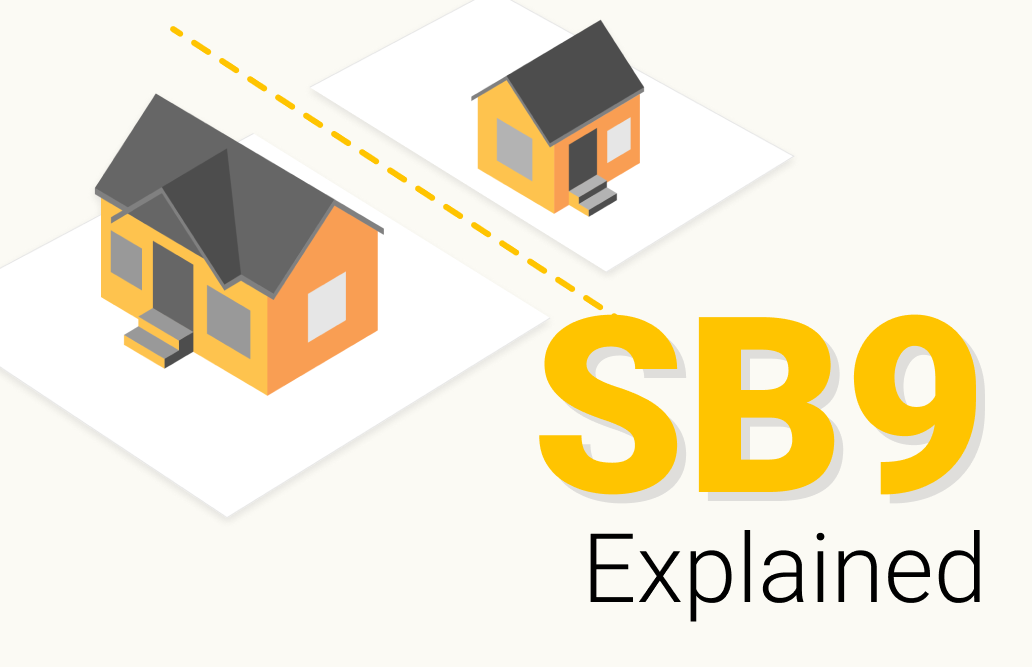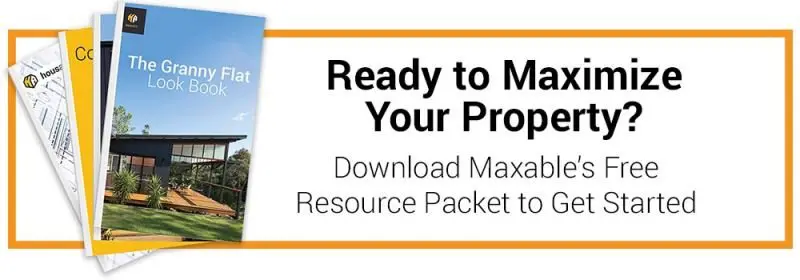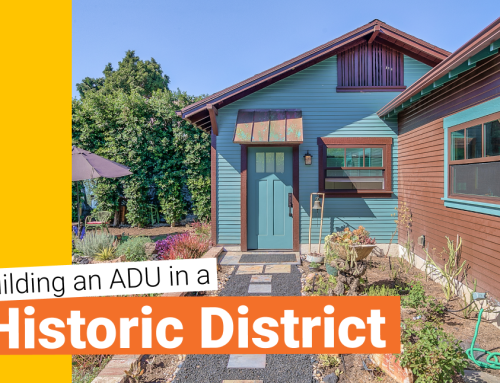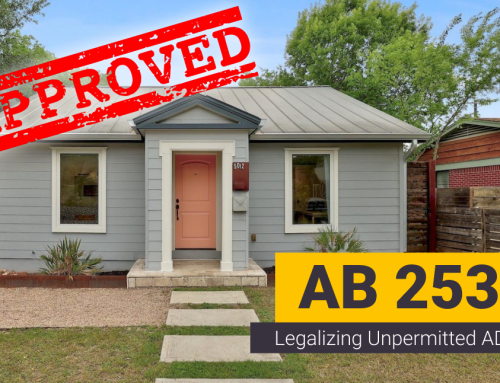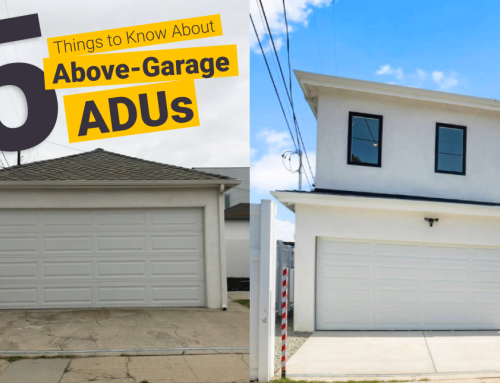If you live in California, you may have heard some talk about “lot-splits” and SB9 recently. Here’s a quick refresher of what transpired within the last few years.
On Jan.1, 2022, California Senate Bill 9 went into effect with the sole purpose of maximizing housing potential on single-family residential lots. One way is through the lot-split provision, which allows homeowners to split their single-family lot into two separate lots.
This provision extends the number of possible dwelling units you can both build and sell, providing more affordable housing opportunities than larger, single-family homes.
Despite the rising need for affordable housing, this bill was a lengthy process in the making. And it’s still relatively new and under-utilized, with several kinks to work out. But it certainly has some great potential, especially as SB9 hopefully gets reworked in the near future.
When you’re ready to start building an ADU, work with Maxable to get connected to reputable contractors in your area. Start by checking your address here!
Now, let’s take a moment to break down the lot-split provision even further.
What is SB9?
SB9 is a new law that allows you to split your property and have up to two dwellings per lot. So if you split a single-family lot, that is four dwellings total!
The two dwellings on each lot can either be permitted as a duplex or as a house plus an ADU or JADU. But no matter how they are permitted, you cannot put more than two dwellings on each split lot.
Keep in mind that since the goal is to create more housing rather than remove existing housing, you cannot demolish any existing rental units that have been rented within the past 3 years. This is true even if you want to demo a structure in order to build a duplex in its place.
Okay, so let’s say you intend to eventually split your lot and sell it. In that case, it’s best to build a new unit as an SB9 duplex and not an ADU.
Why? While few cities do allow ADUs to be sold separately from the primary house, this is done through a process called condo-ization. It is very new since the passing of AB 1033, but so far, there has not been any clarification if this condo-ization process is allowed for SB9 split properties. To be on the safe side, a duplex may offer more flexibility.
So, make sure you consider your long-term goals beforehand. But we’ll talk a bit more about how ADUs play into SB9 later! Check out a free preview of “What is an ADU” on our e-course for a full definition and breakdown of what sets ADUs apart from other housing structures.

Requirements for lot-splits under SB9
Before you get started, here are the basic requirements to know for lot splits under SB9:
- A single-family lot can be split into two lots
- Split only occur once; you cannot split a lot with SB9 multiple times
- Lot splits on adjacent parcels by the same individual (or another party acting on their behalf) is prohibited
- Minimum lot size after splitting is 1,200 sq ft
- Split cannot be greater than 60/40. So, you cannot have one very large lot and one tiny, 1,200 sq ft lot
- Lots are not exempt from mapping acts (i.e. parcel mapping) or from development and other fees
- Local agencies can impose development standards, such as utility easements, right-of-way access, setbacks, etc.
- Local agencies must allow for minimum 800 sq ft units on the lot splits
Another point to take note of is that the second dwelling must be ministerially approved, which is largely a positive thing! “Ministerially” means that the standards must be objective; cities cannot impose subjective style standards (e.g., matching the style of the primary house or neighborhood).
Overall, this helps to simplify and expedite the permitting process for homeowners. As stated above, however, cities can adopt development standards similar to those in ADU legislation, such as maximum height and minimum setbacks.
Also, parking requirements function identically to those for ADUs: no parking space is required as long as the property is within a half mile of public transportation.
Who can benefit from SB9?
Given the requirements for SB9, this bill is best suited for homeowners with (1) a deep lot and (2) a corner lot.
A deep lot is characterized as a property that has a long length relative to its width, offering ample space for subdivision while still maintaining privacy and functionality for both the original and new units. Deep lots typically allow for easier placement of additional structures, providing enough room for setbacks, parking, and outdoor space, making them ideal for lot-splitting or adding accessory units.
Corner lots, on the other hand, are highly advantageous under SB9 because they provide more frontage and access points from two streets. This allows for easier planning when creating separate entrances for new units or subdividing the lot. The added street frontage also increases the curb appeal and marketability of the additional units, making it easier to meet local zoning requirements like parking and access without disrupting the flow of the existing neighborhood.
There are other requirements for SB9 as mentioned before, but these are the key property traits that make a lot particularly well-suited for lot splits or additional units.
Potential benefits and drawbacks of SB9

SB9 is a great way to empower homeowners to invest in their property and expand affordable housing in their community, especially amidst the deepening housing crisis. For people who have been locked out of the housing market due to astronomical prices, the lot-split provision provides a much-needed remedy.
And let’s not forget the financial incentives! The lot-split provision of SB9 allows homeowners to optimize their property’s financial potential, either by selling the new lot or building rental units to generate long-term passive income! Just know that SB9 units cannot be used for short-term (fewer than 30 days) rentals.
Or for those desiring multigenerational living, SB9 enables them to share the property with their relatives!
One notable drawback of SB9 is that development and impact fees are unavoidable if you build a duplex on the property. When you build an ADU under 750 sq ft in California, you do not have to pay any hefty D&I fees. Unfortunately, duplexes are required to pay them, regardless of their size.
Parcel-mapping fees can be quite exorbitant, too. Some older neighborhoods require that their parcels be remapped in order to split lots. The first person to split their lot gets stuck with this parcel-mapping fee, which can be tens of thousands of dollars. We’ve seen them as high as $80,000!

Finding access to a split lot can also be tricky. Corner lots or alley lots are ideal given their easy access. Whereas a property located in the middle of a block will likely need to be reconfigured. But any of this would depend on the city’s right-of-way and easement regulations.
And one potential disadvantage for developers in particular is that owner occupancy is required. This was instilled to prevent them from buying up lots and splitting all of them. Instead, property owners who want to split a lot must sign an affidavit saying that they intend to live on one of the lots for at least 3 years.
A lengthy timeline is another downside to consider. The process for splitting a lot can take anywhere from 18 months to 2 years, and here’s part of the reason why.
Permitting can be a challenge. Many cities have yet to establish a permitting process, which opens up room for delays. And as of now, every city can interpret SB9 in its own way to a certain extent. Therefore, homeowners should understand the limitations and requirements specific to their local ordinance.
Lenders have not yet figured out how to deal with lot splits yet, either, which could lead to complications. If you own the property outright, it’s not a problem. But if you have a mortgage, you’re likely to get a lot of pushback.
SB9 is a complex bill with some kinks to iron out, for sure. But it definitely has the potential to provide relief to the housing crisis by expanding housing opportunities on single-family lots!

How do I qualify for SB9?
Before applying for a lot split, you’ll need to make sure that your property qualifies. Your parcel may be eligible if it’s:
- Located within an urban area or cluster
- Zoned single-family residential
- At least 2,400 sq ft
- Free of tenant evictions within the last 15 years
- Not located within a historic zone, flood zone, fire hazard zone, earthquake zone, hazardous waste site, prime farmland, or within other environmentally protected areas like conservation zones and endangered species habitats
- Not previously been split using SB9
Once you’ve determined your property’s eligibility, you’ll need to decide where the new lot lines will go after the split. It’s a good idea to hire a land surveyor who will assess the property and provide recommendations for new property lines.
Next, you’ll have to get permission from your lender for a partial release of your mortgage (if you have a mortgage). You’ll also need to have a low enough LTV (loan-to-value ratio), and your mortgage must be at least one year old.
If you do not meet these qualifications or your lender won’t agree to a partial release, you’ll need to refinance your loan. In that case, it’s important that your new lender is aware of the lot split plans so that the new mortgage reflects the new (reduced) lot size.
After that, you’re ready to get started with the application! Different jurisdictions have district application requirements, so you’ll need to visit your local City Planning Department’s website or your city’s SB9 ordinance to make sure you have the required documents.

That being said, all SB9 lot-split applications will need a:
- Preliminary parcel map (prepared by a surveyor or civil engineer)
- Certificate of occupancy
- Owner occupancy affidavit
Depending on your jurisdiction and property characteristics, you may also need to provide one or more of the following:
- Certified tree report
- Soils report
- Photos of the property
- Land records map
- Grant deeds
- Habitat statement form
- SB9 urban lot split checklist
Your local jurisdiction may require additional paperwork, so it’s important to double-check with them prior to submitting your application.
Once your application is submitted, the onus is typically on the City Planning Department to review it. You will then be required to pay all applicable fees required by your jurisdiction. After that, just wait for the final approval!
We won’t deny that SB9 can be a bit confusing. Lot splits are still a relatively new concept to most people, so you don’t want to have to tackle it all by yourself. Never hesitate to hire trusted professionals to assist with the process. A trained eye and some professional guidance can go quite a long way!

SB9’s impact so far
Truthfully, SB9 hasn’t accomplished much…yet.
On a small scale, SB9 was meant to encourage homeowners to construct more dwellings on their single-family lot. While the long-term goal was to help alleviate the burden of the current housing crisis by expanding the middle housing sector.
But a 2023 study by the Terner Center for Housing Innovation found that SB9 projects are thus far “limited or nonexistent.” The study focused on areas deemed high-opportunity due to their spikes in ADU construction in recent years.
Although SB9 is still relatively new, a big reason for its inactivity is likely due to aspects of the law that need tweaking. As we mentioned earlier, there are certainly some wrinkles in the system (e.g., very high construction costs) that need to be addressed. And until some of those developmental barriers are removed, it’s easy to see why so few homeowners will consider taking it on.
That being said, we are hopeful that a resolution is on the way. SB9 has the potential to offer fantastic entry-level homeownership opportunities for Californians who are currently outpriced and outcompeted in today’s market, so we’re eager to see it come to fruition!
The Future of SB9
Speaking of resolution, one positive change already seems to be on the horizon for SB9 thanks to upcoming Assembly Bill 1033!
As we mentioned before, California law previously banned ADUs from being sold separately from the main house. But AB 1033 actually removes that ban, allowing individual cities and counties to decide if they want their residents to have the option to sell their ADU separately!
Doing so would allow ADUs to become condoized in California, treating them much like traditional single-family homes!
So, AB 1033 could be game-changing for SB9 by opening up even more housing potential for homeowners wanting to build an ADU and split their lot to eventually sell. It would also increase middle housing options for California residents eager for a genuine shot at homeownership.
Similar bills have gone into effect in cities like Portland and Seattle, and have seen incredibly positive results. You can check out an example of this initiative in action in one of our latest ADU tours.
The more opportunities for affordable and accessible homeownership, the merrier!

Example of a condo-ized ADU in Portland Oregon, by Oregon Homeworks
Final Thoughts on SB9
There’s no denying that SB9 needs some work. But for those willing to shell out the extra cost and time that lot-splits take, they can offer huge long-term advantages with plenty of ROI.
Not only do lot splits double the number of dwellings you can build on a single-family parcel, but they double the benefits, too! We’re eager to see more middle-housing options come to single-family neighborhoods in California, including the financial and housing potential they offer homeowners.
As for AB 1033, it is safe to say that we are cautiously optimistic about this bill passing in the near future. It would create a much more equitable playing field in the housing realm, as well as set a precedent for other states to follow suit.
Click here to continue checking the bill’s status, and keep your fingers crossed!
Plan, hire, and manage your ADU project with Maxable.
See an ADU in your future?
If so, don’t forget to sign up for Maxable’s bimonthly webinar! We’ll make sure you get all your lingering questions answered, so you feel prepared to get started. Plus, we’ll help match you to a vetted contractor with ADU-specific experience in your area to take on your upcoming project.
We hope to see you soon!

